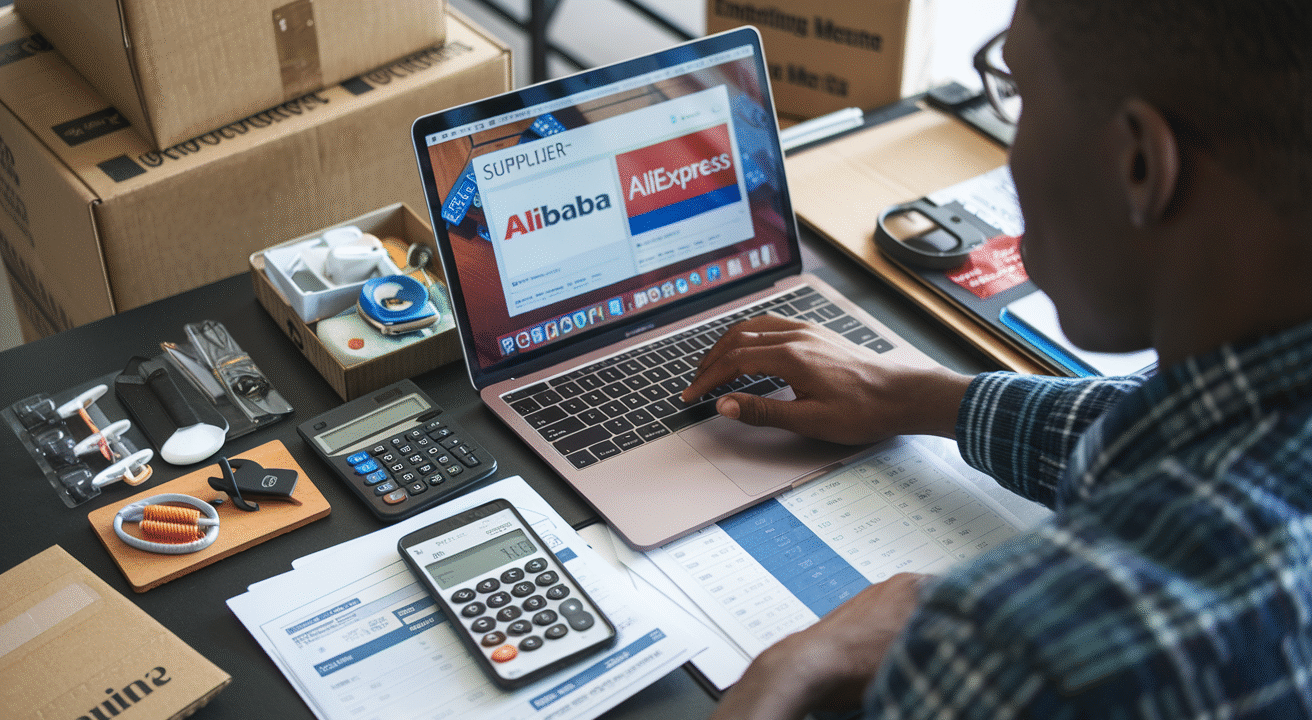
You’re scrolling Instagram and see another “I made $5,000 in my first month of mini importation” post. Is it legit or just another fantasy?
Let me save you months of expensive trial and error. Mini importation isn’t complicated, but there’s a reason 78% of first-timers quit within three months.
This guide walks you through starting a mini importation business that actually makes money, not just Instagram-worthy claims. We’ll cover everything from finding reliable suppliers to clearing customs without drama.
The difference between profitable mini importation businesses and expensive hobbies? It’s not capital. It’s strategy.
Ready to learn why most “gurus” aren’t showing you their actual bank statements? Let’s pull back the curtain.
Understanding Mini Importation Business Fundamentals
What is mini importation and why it’s profitable in 2025
Mini importation isn’t just some fancy business term—it’s literally bringing in small quantities of products from overseas (especially China) and selling them at higher prices locally. The game has changed dramatically in 2025, making it more profitable than ever.
Why is everyone jumping on this train now? Simple. The barriers have fallen. What once required massive capital and connections now needs just your smartphone and a few hundred dollars. Those global shipping nightmares from the early 2020s? Ancient history. Now we have streamlined logistics and faster shipping times that make the whole process practically painless.
The numbers don’t lie—profit margins typically range from 100% to 300% on most items. Think about it: a $5 gadget from China could sell for $15-$20 in your local market. With the new AI-powered market research tools available in 2025, finding those winning products is no longer guesswork.
Plus, the recent global trade agreements have slashed import duties for small-scale importers. This isn’t just good news—it’s practically free money on the table for anyone smart enough to grab it.
Key differences between mini importation and traditional importing
Traditional importing feels like trying to move a mountain. Mini importation? More like carrying a backpack. Here’s what separates them:
| Mini Importation | Traditional Importing |
|---|---|
| $500-$5,000 startup capital | $10,000+ startup investment |
| Order quantities: 10-200 units | Order quantities: 500+ units |
| Payment via PayPal, Wise, cryptocurrency | Letters of credit, wire transfers |
| Shipping via air freight or express | Container shipping by sea |
| 1-3 weeks delivery time | 1-3 months delivery time |
| Low storage requirements | Warehouse needed |
| Easy to pivot between products | Committed to specific inventory |
| Can be run solo | Requires staff |
The beauty of mini importation is flexibility. Having a product that’s not selling? No problem—you’ve only got 20 units to clear, not 2,000. The digital storefronts of 2025 make this even easier, with virtual warehousing solutions that didn’t exist five years ago.
Required startup capital and potential ROI
The financial barrier to entry has never been lower. I’m talking $500-$1,000 to get your feet wet. Seriously.
Here’s a typical mini importation startup budget for 2025:
| Expense Category | Amount |
|---|---|
| Initial inventory | $300-$800 |
| Website/online store setup | $50-$200 |
| Marketing budget | $100-$300 |
| Shipping & logistics | $50-$200 |
| Miscellaneous fees | $50-$100 |
| Total startup capital | $550-$1,600 |
Now for the exciting part—ROI. A well-executed mini importation business typically breaks even within 2-3 months. After that, you’re looking at monthly profits ranging from $1,000 to $5,000, depending on your product selection and marketing savvy.
The math works like this: Import 100 units at $5 each ($500), sell them at $15 each ($1,500), that’s a $1,000 gross profit before expenses. Even after shipping and marketing costs, you’re still clearing $600-$700 profit on a $500 investment. That’s a 120-140% ROI in just one cycle.
Legal requirements and regulations to consider
Nothing kills a business faster than legal troubles. Let’s cut through the red tape:
First, you’ll need a business registration—sole proprietorship works for most beginners, though an LLC offers better protection as you scale. The good news? The 2024 Small Business Simplification Act made this process almost entirely online in most countries.
Tax obligations haven’t disappeared (sorry!). You’ll need:
- Sales tax collection capabilities
- Import duty payments
- Income tax reporting
The 2025 digital customs clearance system has made import documentation much simpler. Most products under $2,000 now go through an expedited process that takes hours instead of days.
Certain product categories still have restrictions—cosmetics, electronics, and food items require specific certifications. The new International Standards Compliance App makes checking these requirements painless.
And don’t forget about product liability. Even small-scale importers need basic insurance coverage—typically $300-500 annually for mini importation businesses with under $50,000 in revenue.
Researching Profitable Products for Importation
A. Trending products with high demand in current markets
Finding hot products is like striking gold in mini importation. Right now, smart home gadgets, eco-friendly products, and health monitoring devices are flying off virtual shelves. Portable blenders and foldable water bottles are crushing it among fitness enthusiasts.
Beauty products with natural ingredients? People can’t get enough of them. And don’t get me started on pet accessories – the market is booming as more people treat their pets like family members.
But here’s the thing – trends shift faster than sand in a storm. A product that’s hot today might be yesterday’s news tomorrow. Keep your finger on the pulse by checking bestseller lists on AliExpress, Amazon, and Jumia regularly.
Social media is your goldmine for spotting the next big thing. Instagram and TikTok practically telegraph what’s about to explode in popularity. Watch what influencers are pushing – they often signal what’s about to trend.
B. Tools for conducting effective market research
You can’t just wing it in this business. You need data. Solid, reliable data.
Google Trends is your free best friend. It shows you what people are searching for in real-time. Want to know if fidget spinners are still a thing? Google Trends will tell you.
AliExpress and Amazon have analytics built right in. They’ll show you bestsellers, rising stars, and customer reviews that tell you exactly what people love and hate.
For more serious research, tools like Jungle Scout and Helium 10 are worth every penny. They’ll give you sales estimates, competition analysis, and keyword data that can make or break your product selection.
Social listening tools like Mention and BuzzSumo help you track what people are saying about products online. Sometimes the chatter starts long before the sales spike.
C. How to identify products with low shipping costs and high margins
The secret sauce of mini importation is finding lightweight, high-value items. That $2 product that sells for $15? That’s what you’re after.
Look for items weighing less than 1kg – shipping costs skyrocket beyond that. Small electronics, fashion accessories, and beauty products usually hit this sweet spot.
The winning formula: high perceived value + low actual cost = fat profits. Phone accessories that cost $1-3 to import but sell for $10-15 are mini importation gold.
Calculate your margins before ordering anything:
- Product cost + Shipping + Customs + Local delivery
- Subtract that from your selling price
- Aim for at least 30% profit margin
Products with strong brand perception but low manufacturing costs are perfect. Think phone cases, fashion sunglasses, and smart watches. The customer sees the style and function, not the actual production value.
D. Avoiding restricted and prohibited items
Getting your shipment seized at customs is a nightmare you don’t need. Some products are flat-out banned or heavily restricted.
Stay away from:
- Medications and supplements
- Weapons or weapon-like items
- Counterfeit designer goods
- Seeds and agricultural products
- Currency and securities
Each country has its own rules. What’s perfectly legal in China might get you in serious trouble in Nigeria, Ghana, or Kenya. Research your country’s import regulations thoroughly before ordering anything.
Even harmless-seeming products like certain toys might contain banned chemicals or fail safety standards. Double-check everything.
The consequences aren’t just losing your shipment – you could face fines or legal action. Trust me, no profit margin is worth that headache. When in doubt, leave it out.
E. Seasonal products versus evergreen products
Should you chase holiday trends or stock reliable sellers? The answer is: both, but strategically.
Seasonal products (like Christmas decorations or Valentine’s gifts) can bring explosive short-term profits. The margins are often incredible because of high demand and emotional purchasing decisions. But they have a short selling window – miss it and you’re stuck with inventory nobody wants.
Evergreen products (phone cases, kitchen gadgets, basic clothing) sell year-round. They provide consistent income without the stress of timing the market perfectly. The competition is fiercer, but you never get stuck with obsolete stock.
Smart mini importers balance their inventory:
- 60-70% evergreen products for stability
- 30-40% seasonal or trending items for higher profits
Start ordering seasonal products 2-3 months before the actual season. This gives you time for shipping delays and marketing buildup.
The real pros combine both approaches – think waterproof phone cases that sell year-round but spike during rainy seasons. Or fitness products that are evergreen but boom during January resolution season.
Finding Reliable Suppliers Abroad
A. Top platforms for sourcing products (Alibaba, AliExpress, etc.)
Finding the right suppliers can make or break your mini importation business. Trust me, I’ve been down this road.
Alibaba is the heavyweight champion here. It connects you directly with manufacturers, offering wholesale prices that’ll make your profit margins sing. The platform has thousands of verified suppliers, and you can order samples before committing to larger quantities.
AliExpress is perfect for beginners. Think of it as Alibaba’s little sibling that doesn’t require huge orders. You can start with just one piece! The downside? Slightly higher prices than Alibaba, but the low barrier to entry makes it worth it.
DHgate flies under the radar but delivers solid results. They specialize in smaller quantities and have strong quality control measures. Their dispute resolution system is also top-notch.
Global Sources is where you go when you’re ready to level up. They’re more selective with suppliers, meaning higher quality but also higher prices.
Made-in-China offers a decent alternative with strict verification processes for suppliers.
I once found a supplier on 1688.com (Alibaba’s Chinese version) who offered prices 30% lower than international platforms. The catch? You’ll need a translator or to use Google Translate. But for those margins, it’s worth the extra effort.
B. How to verify supplier credibility and product quality
Diving into business with an unknown supplier is like going on a blind date – exciting but potentially disastrous. Here’s how to avoid getting burned:
Check their verification status. Look for “Gold Supplier,” “Verified Supplier,” or “Trade Assurance” badges. These aren’t foolproof but add a layer of security.
Request samples before bulk orders. Always. No exceptions. I once skipped this step and ended up with 500 phone cases that fell apart faster than a house of cards. That $200 sample fee would’ve saved me thousands.
Dig into their trade history. How long have they been on the platform? What do their transaction records look like? A supplier with 5+ years and consistent orders is typically more reliable than a newcomer.
Scope out their factory. Ask for a virtual tour via video call. Legit manufacturers won’t hesitate to show you around.
Verify certifications. Different products require different certifications. Electronics need CE or UL, while textiles might need OEKO-TEX. Ask for these documents and verify them independently.
Read between the lines in reviews. Look for specific comments about product quality, communication, and shipping times. Generic praise isn’t helpful.
Use background check services. Companies like Globis and Asiainspection offer verification services that can save you from scammers.
C. Negotiating prices and minimum order quantities
Negotiation isn’t just about getting the lowest price – it’s about creating a win-win situation. Here’s the playbook:
Do your homework first. Contact multiple suppliers and compare quotes. Knowledge is power when you’re at the negotiating table.
Start with MOQ (Minimum Order Quantity). Many suppliers list high MOQs to filter out non-serious buyers. But these numbers are rarely set in stone. I’ve talked suppliers down from 1000 units to 200 by showing I’m serious about building a long-term relationship.
Bundle different products. Can’t meet the MOQ for one item? Ask if you can split it across different products from the same supplier.
Time your negotiations strategically. Approach suppliers during off-seasons when they’re hungry for orders. Chinese New Year? Not the time to negotiate.
Use Trade Assurance where available. It protects your payment and gives you leverage if quality issues arise.
Consider your payment terms. Instead of the standard 30% deposit and 70% before shipping, negotiate for 30/70 after inspection or 20/80 terms.
Ask for free samples or shipping on larger orders. Suppliers often have wiggle room here, especially if they see potential for ongoing business.
Be respectful but firm. Aggressive tactics might work once, but they’ll destroy any chance of a long-term relationship.
D. Building long-term relationships with suppliers
The secret sauce to mini importation success? Strong supplier relationships. One-off transactions won’t get you the best deals.
Communication is key. Be clear, concise, and prompt in your messages. Language barriers exist, so use simple English and confirm understanding.
Pay on time, every time. Nothing builds trust faster than reliability with payments. My best supplier discounts came after my third order, when they realized I was dependable.
Share your business growth. Keep suppliers informed about your success with their products. When they see you growing, they’re more invested in your success.
Send occasional gifts. A small gesture during Chinese holidays can go a long way. I send my main supplier a gift basket during Chinese New Year, and I always get priority treatment.
Visit in person when possible. Nothing beats face-to-face meetings. Consider attending trade shows like the Canton Fair or even visiting your key suppliers’ facilities.
Provide constructive feedback. If there are quality issues, approach them as problems to solve together rather than accusations.
Understand cultural differences. Business practices vary globally. In China, building personal connections (guanxi) matters as much as the business terms.
Place regular orders. Consistency is valued highly. Even small, regular orders are better than one huge order followed by silence.
By nurturing these relationships, you’ll eventually unlock better prices, priority production slots, and even customization options that aren’t available to new customers.
Setting Up Your Mini Importation Business
Choosing between e-commerce and physical store models
Picking the right business model isn’t just a minor detail—it’s the backbone of your mini importation business. Trust me, this decision will shape everything from your startup costs to your daily operations.
E-commerce is the go-to for most mini importation entrepreneurs in 2025, and for good reason. With platforms like Shopify, WooCommerce, and even Instagram shops, you can launch with minimal overhead. No rent, no utilities, no store fixtures. Just upload your product images, set your prices, and you’re practically in business.
But physical stores still have their charm. People love touching products before buying, especially unique imported items. The face-to-face interaction builds trust that’s hard to replicate online.
Here’s a quick comparison:
| E-commerce | Physical Store |
|---|---|
| Lower startup costs | Higher initial investment |
| 24/7 operation | Limited business hours |
| Unlimited geographic reach | Local customer base |
| No face-to-face customer interaction | Personal shopping experience |
| Easier to scale | Higher operational complexity |
Many successful importers actually start online and open a physical location once they’ve built a customer base. This hybrid approach gives you the best of both worlds.
Creating a business plan for your mini importation venture
Skip the 50-page business plan nobody will read. Focus on what actually matters for your mini importation business.
Your plan should zero in on these key areas:
-
Market research: Who’s buying what you’re selling? What’s the competition doing? Where’s the gap you can fill?
-
Product selection: List 5-10 products you’ll start with. Include supplier details, costs, and target selling prices.
-
Sourcing strategy: How will you find reliable suppliers? Will you use platforms like Alibaba, AliExpress, or work directly with manufacturers?
-
Pricing model: Calculate your profit margins after accounting for product cost, shipping, customs duties, and other fees.
-
Marketing approach: How will customers find you? Social media? SEO? Paid ads? Word of mouth?
-
Financial projections: Start simple—estimate your monthly sales, expenses, and profit for the first year.
-
Growth milestones: What does success look like at 3, 6, and 12 months?
Your business plan isn’t set in stone. The mini importation landscape changes quickly, and your plan should evolve too. Review it quarterly and adjust as needed.
The best plans are living documents that guide decisions, not dusty files you never look at again.
Registering your business and obtaining necessary permits
Paperwork isn’t sexy, but skipping it can shut down your mini importation business before it even starts.
First, choose a business structure. In most countries, you’ve got options:
- Sole proprietorship (simplest but offers no personal liability protection)
- Limited liability company (LLC)
- Corporation
For mini importation, an LLC often hits the sweet spot—it protects your personal assets while keeping things relatively simple.
Next, register your business name. Check if your desired name is available through your local business registry or secretary of state’s office.
You’ll also need these basics:
- Business tax identification number
- General business license from your city or county
- Import license (requirements vary by country)
- Sales tax permit if you’re selling physical goods
Don’t forget about import-specific requirements:
- Customs bond (required in many countries for formal entries)
- FDA registration (if importing food, cosmetics, or medical devices)
- Product certification for certain categories (electronics, toys, etc.)
The exact requirements vary wildly depending on your location and what you’re importing. Spend an afternoon researching your specific situation or chat with a business attorney familiar with import regulations.
One mistake can cost you thousands in seized merchandise or penalties, so this isn’t the place to cut corners.
Setting up payment systems for international transactions
The money side of mini importation can make or break your business. You need systems that are reliable for both paying suppliers and receiving customer payments.
For paying suppliers:
- Wire transfers: Old school but reliable. Higher fees but accepted everywhere.
- PayPal: Convenient but watch those currency conversion fees.
- Wise (formerly TransferWise): Lower fees than banks for international transfers.
- Alibaba Trade Assurance: Offers protection when buying from verified Alibaba suppliers.
- Letter of Credit: For larger orders, provides security for both you and the supplier.
For receiving customer payments:
- Payment gateways: Stripe, PayPal, Square all integrate with most e-commerce platforms.
- Buy-now-pay-later options: Klarna, Afterpay, and Affirm can boost your average order value.
- Mobile payment solutions: Don’t forget about Apple Pay, Google Pay, and other digital wallets.
- Cryptocurrency: Bitcoin and stablecoins offer lower fees for international commerce in 2025.
Set up at least two payment methods for both paying suppliers and receiving customer payments. Systems go down, accounts get frozen—you need backups.
Remember that exchange rates fluctuate. Build a small buffer into your pricing to account for currency changes, or you might find yourself selling at a loss when your supplier’s currency strengthens against yours.
Test your payment systems thoroughly before launching. Nothing kills sales momentum faster than a checkout process that doesn’t work.
Mastering the Logistics of Importation
Understanding shipping methods and their cost implications
Shipping can make or break your mini importation business. No kidding.
The most common shipping methods include:
- Express shipping (DHL, FedEx, UPS): Fast but pricey. Gets your products to you in 3-7 days.
- Air freight: Good middle ground for medium-sized orders. Takes about 8-14 days.
- Sea freight: Cheapest for bulk orders but slowest (30-60 days).
Here’s what impacts your shipping costs:
- Weight and dimensions (volumetric weight)
- Shipping distance
- Delivery speed
- Insurance (don’t skip this!)
Pro tip: Many newbies burn their profits by choosing express shipping for everything. For smaller items under 2kg, ePacket or AliExpress Standard Shipping often gives you the best bang for your buck.
Customs clearance procedures and documentation
The paperwork nightmare that scares off most beginners? It’s actually manageable.
Essential documents you’ll need:
- Commercial invoice (shows what you bought and for how much)
- Bill of lading/airway bill (your shipment’s “passport”)
- Packing list (inventory of what’s in each package)
- Certificate of origin (proves where your goods came from)
Most countries now have online customs platforms. In Nigeria, for example, the Nigeria Customs Service has the NICIS II platform where you can submit documentation electronically.
The process typically follows this pattern:
- Submit documentation
- Pay applicable duties and taxes
- Inspection (if selected)
- Release of goods
Calculating import duties and taxes accurately
Nothing kills profits faster than surprise customs fees.
Import duties vary wildly based on:
- Product category
- Country of origin
- Value of goods
- Local tax regulations
Most countries use the Harmonized System (HS) code to classify products and determine duty rates. Find your product’s HS code before ordering to avoid nasty surprises.
For rough calculations:
Total landed cost = Product cost + Shipping fee + (Product value × Duty rate) + VAT/Sales tax + Handling fees
Smart importers build a 15-20% buffer into their pricing to cover unexpected customs charges.
Tracking shipments and managing delivery timeframes
The anxiety of wondering “where’s my stuff?” is real.
Best practices for tracking:
- Always get a tracking number for every shipment
- Use tracking apps like 17Track or Parcels that combine multiple carriers
- Set up email/SMS alerts for status changes
- Document all tracking milestones
Create a simple spreadsheet with:
- Order dates
- Expected arrival dates
- Tracking numbers
- Status updates
When delays happen (and they will), be proactive. Contact your supplier or shipping company immediately—don’t wait until your customer starts asking questions.
Working with freight forwarders versus direct shipping
As your business grows, this decision becomes crucial.
Direct shipping works when:
- You’re just starting out
- Order volumes are small
- You’re testing new products
Freight forwarders make sense when:
- Your order volume increases
- You need consolidated shipping
- You want someone to handle customs clearance
- You’re importing from multiple suppliers
Good freight forwarders aren’t just middlemen—they’re partners who:
- Negotiate better shipping rates
- Handle documentation
- Provide warehousing
- Solve customs issues
- Consolidate shipments
The real MVPs? Freight forwarders who specialize in small-scale imports. They understand your challenges and won’t treat you like a second-class customer because you’re not moving container loads.
Marketing Your Imported Products
Creating a strong brand identity for your business
Think about it. You’re scrolling through Instagram and see two sellers offering the same imported product. One has a consistent look, professional photos, and a memorable name. The other? Random posts and a generic business title. Who gets your money?
Your brand is what sticks in people’s minds when they’re ready to buy. For your mini importation business, you need:
- A catchy, relevant business name (not just “John’s Imports”)
- A simple logo that works on small screens
- Consistent colors and fonts across all platforms
- Professional product photography
- A clear brand story explaining why you started importing
I’ve seen too many importers skip this step and wonder why sales aren’t happening. Your products might be amazing, but without solid branding, potential customers scroll right past.
Effective pricing strategies for maximum profit
Pricing imported goods is tricky. Price too high, customers bail. Price too low, you’re eating ramen for dinner.
Here’s what actually works:
-
Cost-plus pricing: Calculate your total costs (product + shipping + customs + marketing) and add your desired profit margin (usually 30-50% for imported goods).
-
Value-based pricing: What problem does your product solve? The bigger the problem, the more people will pay.
-
Tiered pricing options: Offer good, better, best versions at different price points.
-
Bundle pricing: Package complementary products together at a slight discount.
Most mini importers make the rookie mistake of just checking what competitors charge. Bad move. Your costs and value proposition are different.
Instead, test different price points with small batches. Track which ones give you the best profit-to-sales ratio, not just total revenue.
Digital marketing tactics that work for import businesses
The digital marketing landscape changes fast, but some tactics consistently deliver for mini importation businesses in 2025:
Email marketing still crushes it for ROI. Build your list from day one. Send mix of educational content (how to use your products) and promotions.
Content marketing works wonders. Create comparison guides between local alternatives and your imported products. Show the quality difference.
Influencer collaborations remain powerful for imported goods. Find micro-influencers (10K-50K followers) in your niche who can demonstrate your products authentically.
Google Shopping ads are worth the investment for physical products. They show your product image, price, and shop name directly in search results.
Retargeting campaigns target people who visited your store but didn’t buy. These convert at 3-5x the rate of cold traffic.
Many importers blow their budget on flashy TikTok campaigns but neglect these proven channels. Big mistake.
Leveraging social media to showcase imported products
Social media is your showroom. Unlike physical stores, people can’t touch your imported products before buying. Your social presence needs to fill that gap.
Platform-specific strategies that move product:
Instagram: Post high-quality product photos with lifestyle context. Use Reels to demonstrate product features and benefits. Create shopping tags for direct purchasing.
TikTok: Share behind-the-scenes of your importation process. People love seeing those “just arrived from overseas” unboxing videos. Create comparison videos between your imported products and local alternatives.
Facebook Groups: Create a community around the problem your imported products solve, not just a promotional channel.
Pinterest: Perfect for imported home goods, fashion, and decor. Create boards around specific lifestyles that incorporate your products.
The mini importers crushing it don’t just post product photos with boring captions. They show the products in action, addressing specific pain points their audience experiences.
Remember to highlight what makes your imported products special – unique features, superior materials, or innovative designs unavailable locally.
Managing Finances and Scaling Your Business
A. Record-keeping and accounting best practices
Running a mini importation business without proper financial tracking is like driving with your eyes closed. Trust me, I’ve seen too many promising businesses crash because they couldn’t tell profit from revenue.
Start with these essentials:
- Separate business and personal finances: Open a dedicated business account today. Not next week. Today.
- Digital accounting software: QuickBooks, Wave, or Zoho Books will save you countless headaches when tax season rolls around.
- Receipt management: Take pictures of every receipt using apps like Expensify. Your future self will thank you.
- Track every transaction: Every penny that comes in or goes out needs documentation.
I recommend creating three crucial spreadsheets:
- Product cost tracker (including shipping and customs)
- Sales record (with profit margins for each product)
- Monthly expense summary
B. Reinvesting profits to grow your inventory
The fastest path to scaling your mini importation business? Smart reinvestment.
Most successful importers follow the 50/30/20 rule:
- 50% reinvested into inventory expansion
- 30% reserved for operations and emergencies
- 20% taken as personal profit
When reinvesting, prioritize:
- Products with proven sales history
- Complementary items to existing bestsellers
- Seasonal products (bought 3-4 months ahead)
A client of mine started with just $500 importing phone accessories. By religiously reinvesting 60% of profits for the first year, she now manages a $35,000 monthly inventory without taking any loans.
C. When and how to hire additional help
Your time has value. Calculate it. When processing orders takes more than 4 hours daily, it’s time for help.
Start with these part-time roles:
- Virtual assistant: For $5-10/hour, they can handle customer service and order processing.
- Logistics coordinator: Once you’re shipping 50+ packages weekly, this becomes essential.
- Social media manager: When marketing starts cutting into your strategic thinking time.
Interview tip: Give candidates a paid test task rather than just talking. Actions reveal more than words.
D. Expanding your product line strategically
Random expansion is a rookie mistake. Strategic expansion is how you build an empire.
Follow this product expansion framework:
- Vertical expansion: Go deeper in your current category (e.g., from phone cases to all phone accessories)
- Horizontal expansion: Target the same customers with different product categories
- Upstream/downstream expansion: Add products your customers need before or after using your current offerings
The key metric? Customer acquisition cost should decrease as your product line expands.
Test new products with small batch orders (5-10 units) before committing to larger inventory. This approach has saved me thousands in potential losses on trendy items that looked promising but flopped in reality.
Overcoming Common Challenges in Mini Importation
Dealing with shipping delays and lost packages
Mini importation can be a rollercoaster ride, especially when packages decide to take scenic routes or go on unexpected vacations. Trust me, I’ve been there—refreshing tracking pages like it’s my full-time job!
The trick is to build buffer time into every order. Tell your customers delivery will take 25-30 days when you expect it in 15-20. When it arrives “early,” you’re the hero.
Always, always get tracking numbers. No exceptions. And screenshot everything—order confirmations, payment receipts, tracking updates. These become your lifeline when things go sideways.
For high-value orders, shipping insurance isn’t optional—it’s essential. The small premium pays for itself the first time a package disappears.
Create a simple system to follow up on orders:
- Day 15: Check tracking status
- Day 25: Contact supplier if no movement
- Day 35: Begin claim process if needed
Pro tip: Develop relationships with multiple shipping agents. When one lets you down (and they will), you’ll have alternatives ready.
Handling customer complaints and product returns
Nothing tests your business skills like an angry customer message at 2 AM. The good news? How you handle returns can turn complainers into loyal fans.
First rule: Don’t take it personally. Product issues happen to everyone in this business.
Create a crystal-clear return policy before you need one. Display it everywhere—your website, social media, order confirmations. Make it fair but protect yourself from return abuse.
When complaints roll in:
- Respond quickly (within hours, not days)
- Listen completely before defending
- Offer solutions, not excuses
- Document everything
For minor issues, replacement often costs less than return shipping. For bigger problems, partial refunds can save relationships without breaking your bank.
Keep a “problem product” spreadsheet. When you notice patterns, drop those items from your inventory immediately.
Managing currency fluctuations and international payment issues
The exchange rate game can make or break your profits overnight. I’ve watched margins evaporate because I didn’t pay attention to currency shifts.
Smart importers check exchange rates daily. Set price alerts on currency apps to notify you of significant changes.
Consider these payment protection strategies:
- Pay suppliers in batches rather than individual orders
- Use stable payment platforms like PayPal Business or Wise
- Build a 5-10% currency fluctuation buffer into your pricing
- For large orders, explore forward contracts to lock in rates
Payment disputes happen. Document every transaction meticulously. Screenshot payment confirmations, save transfer receipts, and keep all communication records.
Create separate bank accounts for your business transactions. This separation makes tracking easier and protects your personal finances.
Staying competitive in a growing market
The mini importation space gets more crowded every day. Your competitive edge comes from being nimble where larger businesses can’t.
Speed is your superpower. While bigger companies get stuck in meetings, you can spot trends and act immediately. Follow niche influencers on TikTok and Instagram to catch products before they blow up.
Product curation matters more than ever. Don’t import everything—import the right things. Test small batches of 3-5 potential winners rather than gambling on one big order.
Differentiation strategies that work:
- Bundle complementary products together
- Create themed collections around seasons or interests
- Offer personalization services
- Develop exclusive packaging
The most successful mini importers become product experts. Learn everything about what you sell—materials, manufacturing processes, common issues. When customers ask questions, your expertise builds instant trust.
Remember, customer service is where small businesses shine. Answer messages at odd hours. Remember customers’ names. Send handwritten thank-you notes. These small touches create loyalty that algorithms can’t touch.
Starting a mini importation business offers a flexible path to entrepreneurship with relatively low initial investment. By understanding the fundamentals, researching profitable products, and building relationships with reliable suppliers, you can establish a sustainable business that meets market demands. The key to success lies in mastering logistics, implementing effective marketing strategies, and maintaining sound financial management as you scale.
Take the first step today by researching products in your area of interest and exploring supplier options on platforms like Alibaba or AliExpress. Remember that persistence is crucial as you navigate customs regulations and logistics challenges. With careful planning, continuous learning, and adaptability to market changes, your mini importation business can grow from a side hustle into a thriving enterprise that provides valuable products to your local market while creating financial independence for yourself.











No Comments